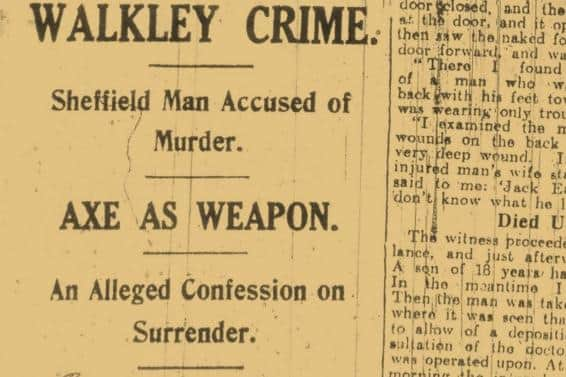Have you heard of the Christmas execution of a Sheffield man who murdered a bartender who had gotten 'friendly' with his wife back in 1923?
and live on Freeview channel 276
And to complicate matters further, in the weeks prior to the killing. Eastwood had left his wife of 22 years and ran away to Liverpool with one of the pub’s female regulars.
But the relationship had soured after a couple of weeks and Eastwood, a former chimney sweep, had returned to Sheffield with his tail between his legs, begging his wife for forgiveness.
Advertisement
Hide AdAdvertisement
Hide AdBut Ethel Eastwood would have none of it, and even transferred the tenancy of the pub they had run together - the long gone Bay Horse Hotel in the Walkley area of the city - forcing Eastwood, 39, into temporary lodgings.


The couple had run the pub together for about 18 months prior to Eastwood’s infidelity, with a woman by the name of Mildred Parramore who, at 22, was only two years older than Eastwood’s daughter.
On the night of the murder, July 30, 1923, Eastwood had been seen drinking with his victim John Clark earlier in the day, but had stolen a hatchet from the pub’s cellar and returned to his lodgings where he was heard to state that he was going to “knock him up”.
He then went to Clark’s home in Lister Road and woke him up, along with his wife and son, by throwing pebbles at their bedroom window.
Advertisement
Hide AdAdvertisement
Hide AdWhen Mr Clarke went downstairs and opened the door to him, he struck him on the head with the hatchet, and reigned two further blows as he lay dying on the floor.
Eastwood then returned to his lodgings in Daniel Hill Street and threw in his keys, telling his landlord he “wouldn’t be needing them anymore”.
After that, he hid the hatchet and turned himself in at the police station, immediately admitting the killing and asking them to attend the Clarks’ home.
Clark was rushed to hospital but was pronounced dead at about 8am the following morning.
Advertisement
Hide AdAdvertisement
Hide AdThe legal process moved relatively quickly, with an inquest carried out on July 31 returned a decision of wilful murder and Eastwood was committed for trial on August 21.
It was here that a history of mental illness emerged in the Eastwood family, and would form a fundamental part of the killer’s defence.
At Eastwood’s trial, which started on December 7, 1923, his defence team tried to argue a case of guilty but insane, which was roundly rejected by the jury at Leeds Assizes. He had premeditated the killing, they decided, and immediately turned himself in to the police, they decided.
Evidence at the trial also revealed that Eastwood had been having murderous thoughts against Clark for weeks, as well as his own family.
Advertisement
Hide AdAdvertisement
Hide AdHe was executed at Armley Jail on December 28 and had to be assisted to the gallows, according to reports from the time. His final words were stated to be: “I never meant it.”